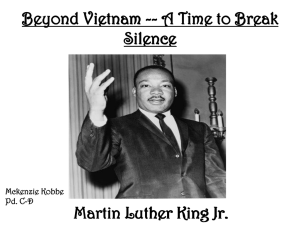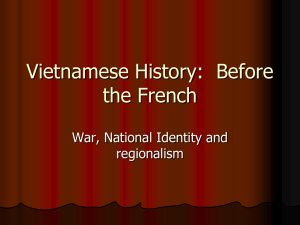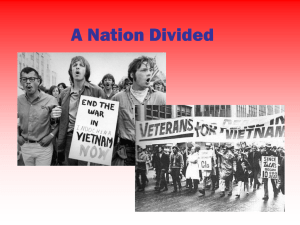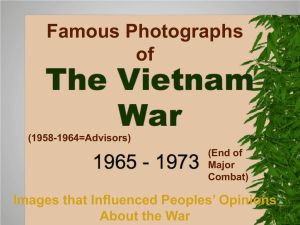1960s Powerpoint - Joshua Independent School District
advertisement
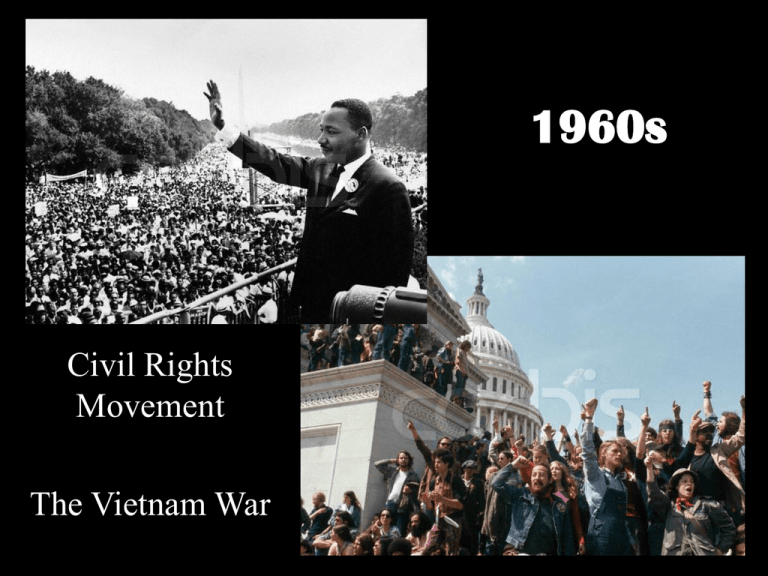
1960s Civil Rights Movement The Vietnam War Civil Rights Movement 50s-60s The US promised full equality to African Americans after the Civil War. BUT Jim Crow laws in the South, residential segregation in the North, and periodic violence throughout the country had kept African Americans from achieving true equality. Civil Rights Movement Jackie Robinson became the 1st African American baseball player to cross the “color line” and join the major leagues. Civil Rights Movement Brown v. Board of Education, 1954 • Reversed Plessy v. Ferguson (1896) that stated that “separate but equal” is ok in public facilities • NAACP argued that when an African American student was denied entry into an all-white public school near her home that segregated public schools denied “equal protection under the law” guaranteed under the 14th Amendment • It outlawed discrimination & segregation in public education and led the way for desegregation in other areas. Segregated Classroom Civil Rights Movement Little Rock High School • Governor of Arkansas denied 9 black students admission to all-white high school • President Eisenhower sent in federal troops to ensure that the students could attend Civil Rights Movement • • • • • Montgomery Bus Boycott, 1955-1956 Rosa Parks took a seat in the section of a bus reserved for whites in Montgomery, Alabama She was arrested for not giving up her seat to a white passenger Her arrest inspired Dr. Martin Luther King, Jr. to begin a 13-month boycott of Montgomery’s public buses. 50,000 African Americans in the city walked, used bicycles, or joined car pools to avoid using city buses. It achieved it’s goal in desegregating the buses and Dr. King emerge as a leader Rosa Parks Civil Rights Movement Freedom Rides in the South 1960-61 Interracial groups rode interstate and local buses in Freedom Rides through the South to help African Americans register to vote Martin Luther King, Jr. • 1957—formed the Southern Christian Leadership Conference to mobilize Southern churches on behalf of civil rights • Believed that oppression could be overcome through nonviolent resistance. By refusing to obey unjust laws, the oppressed would confront their oppressors with their own injustice. • 1960s—led lunch counter sit-ins aimed at ending segregation in department stores African American protestors being sprayed with fire hoses Martin Luther King, Jr. 1963—he was arrested while demonstrating in Alabama. He issued his “Letter from a Birmingham Jail,” in which he explained that African Americans could wait no longer in demanding equality Martin Luther King, Jr. 1963—led the March on Washington and delivered his “I Have a Dream speech,” where he outlined his vision of a future America in which people of all races would someday live together in brotherhood Martin Luther King, Jr. • Civil Rights Act of 1964 passed—prohibited discrimination based on race, religion, or ethnic origins in hotels, restaurants, and places of employment doing business with the federal government. • 24th Amendment (1964) eliminated poll taxes in federal elections • 1965—focused on voting rights with a march from Selma to Montgomery • Voting Rights Act of 1965 passed—ended poll taxes and literacy tests in all states Affirmative Action 1965 • President Johnson signed an executive order requiring employers with federal contracts to raise the number of their minority and female employees to correct past imbalances. • It also increased minority representation in colleges and the professions. Black Power • In the North, African Americans faced segregation based on where they lived—ghettos in the inner cities • When Martin Luther King, Jr. was assassinated in 1968, frustration erupted in a series of riots. • Militants believed in “Black Power”—that African Americans should have pride in themselves, be compensated for past mistreatment, and be in control of their own communities. Black Power Malcolm X believed African Americans should meet violence with violence. “Any means necessary” 1968 Olympics Women’s Liberation Movement • To achieve economic and social equality for women • Feminists like Betty Friedan wrote about the frustration that women felt at being limited to homemaking and motherhood • Many women had been active in the Civil Rights Movement. Its success inspired women to adopt similar tactics to promote women’s rights, such as lobbying, sit-ins, and mass demonstrations. Women’s Liberation Movement • Because of affirmative action, all-male colleges became co-ed and hired women professors. • In 1963, the Equal Pay Act was passed requiring companies to pay women the same wages as men when performing the same work. • Feminists introduced the title Ms. To replace Miss. or Mrs. Hispanic Americans • Cesar Chavez, a migrant farm worker, helped organize fellow workers, most of whom were Spanish-speaking. • 1965—Chavez led California grape-pickers in a 5 year strike. • They formed the United Farm Workers of America and won better conditions for grape-pickers, lettuce growers and other migrant farm workers. Cesar Chavez Cold War continued… • In Latin America • 1959 Cuba became Communist led by Fidel Castro • Bay of Pigs— American supported assassination attempt failed Cuban Missile Crisis • 1962—US discovered that the Soviets were secretly building bases in Cuba to house nuclear missiles aimed at the US (in retaliation to US bases in Turkey) • President Kennedy imposed a naval blockade around Cuba • During the Crisis, both sides threatened each other with nuclear war. • Khrushchev finally withdrew the missiles in return for a promise never to invade Cuba Soviet missile base in Cuba Soviet ship bringing missiles to Cuba Berlin Wall • 1961—the Soviets built a wall to separate Communist and nonCommunist Berlin • It became a somber symbol of the Cold War • It stopped the flow of East Germans to the West and possible defection. Building the Berlin Wall Looking through the barbed wire over the Berlin Wall to Brandenburg Gate Berlin Wall: East Communist & West Democratic Vietnam War • 1954—Vietnamese win their independence from France • Geneva Conference divides Vietnam into 2 separate nations • Vietnamese Communists, led by Ho Chi Minh, were given control of the North. • A non-Communist state was established in the south • Vietnam would be reunited after free elections Ho Chi Minh Vietnam War Why America got involved? President Kennedy and others believed that if South Vietnam fell to Communism, other Asian nations would soon follow, falling like a row of dominoes. Based on this Domino Theory, Kennedy sent military advisors to help defend South Vietnam, hoping it would develop into a democratic nation. Vietnam War America’s Role Expands • 1964—Congress gave President Johnson authority to halt Vietnamese aggression in the Gulf of Tonkin Resolution. • Over the next 3 years, LBJ sent large numbers of US troops to Vietnam. • 1968—Vietcong launched attacks throughout South Vietnam in the Tet Offensive, showing Americans they were far from winning the war LBJ visits Vietnam Buddhist monks protested Diem’s regime (ruler of South Vietnam) and American interference American planes dump napalm on Vietnam to burn away the forest to deter ambush and the advantages of the Vietcong Napalm girl—this village just had napalm dumped on it This is why they tried to burn off all the foliage Zippo Raid To burn suspected safe houses for Vietcong Anti-War Demonstrations at Home • Many young people challenged the materialism of American society. • They were shocked at their parents’ indifference to poverty and racism. • Many youths focused on US involvement in Vietnam and the military draft. • 26th Amendment passed—giving 18 years old the right to vote, because people felt it was unfair to draft young men to fight when they could not even vote to support or oppose it. Kent State Protest where students were fired on Burning draft card Hanoi Jane Jane Fonda in protest of the war went to North Vietnam and had her picture taken with Vietcong soldiers Vietnam War • Richard Nixon campaigned for President in 1968, promising to bring “peace with honor” in Vietnam. • BUT the war dragged on for 5 more years • Unable to achieve victory, Nixon began withdrawing US forces • 1973—the US reaches an agreement with the North Vietnamese so the US withdrew Vietnam War • 1975—the last of our troops were pulled out as Saigon, capital of South Vietnam, falls to the Communist. • We had all our troops out (except a # of POWs) and as many South Vietnamese as could be carried out (mainly because they aided us and would be tortured by the Communists) Fall of Saigon--1975
![vietnam[1].](http://s2.studylib.net/store/data/005329784_1-42b2e9fc4f7c73463c31fd4de82c4fa3-300x300.png)


